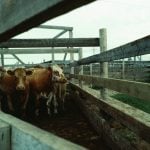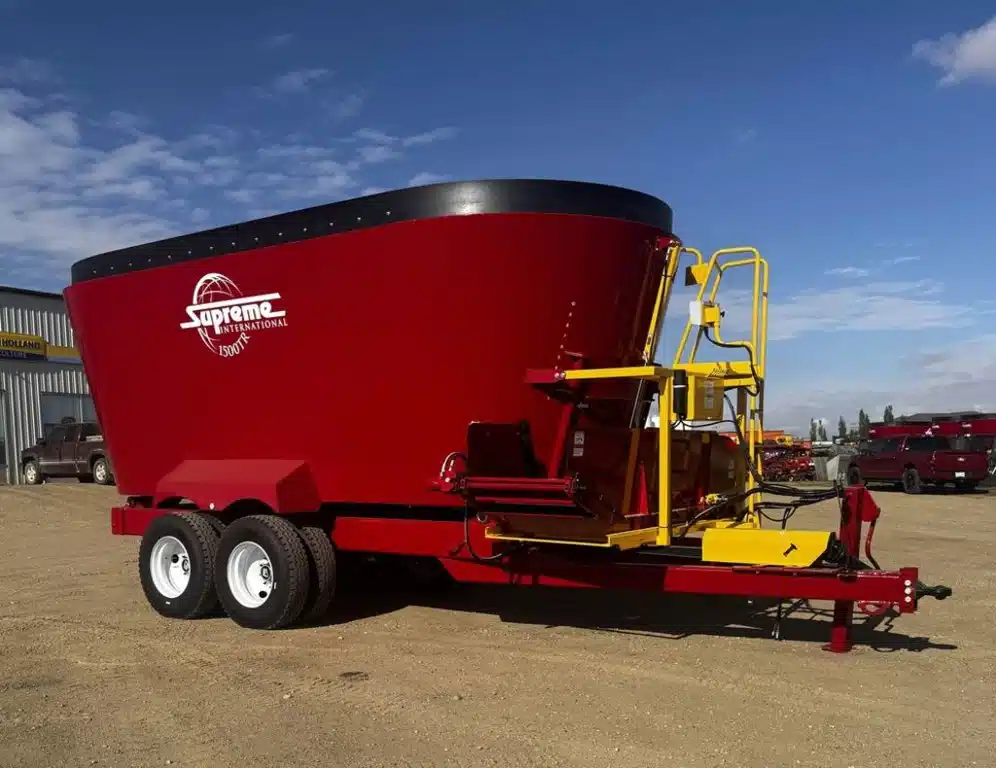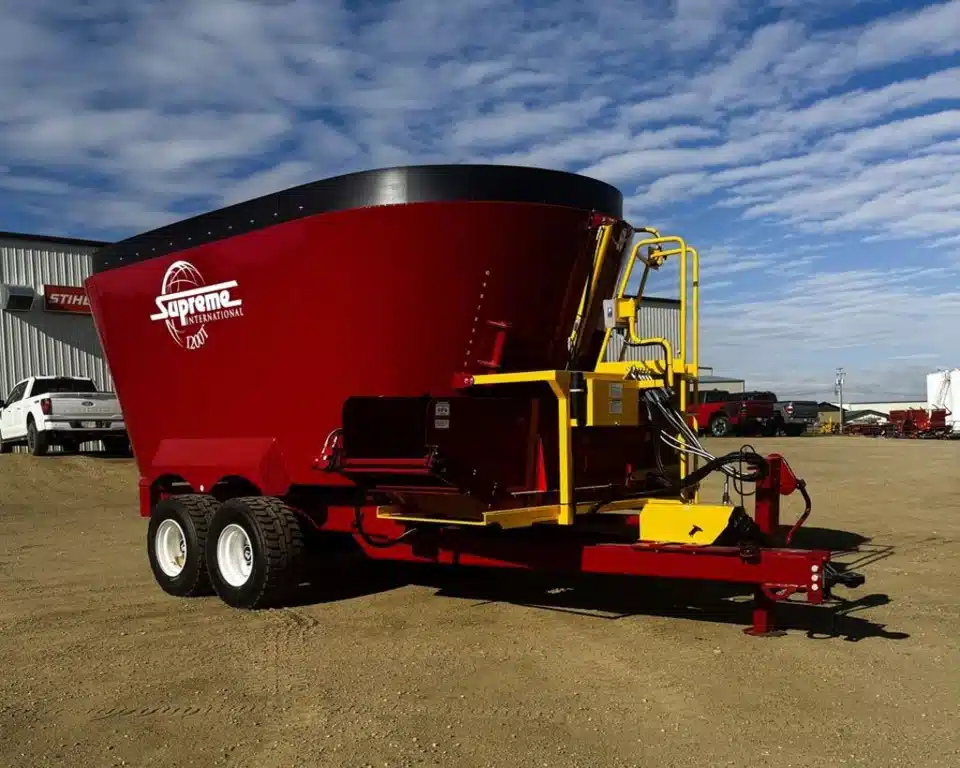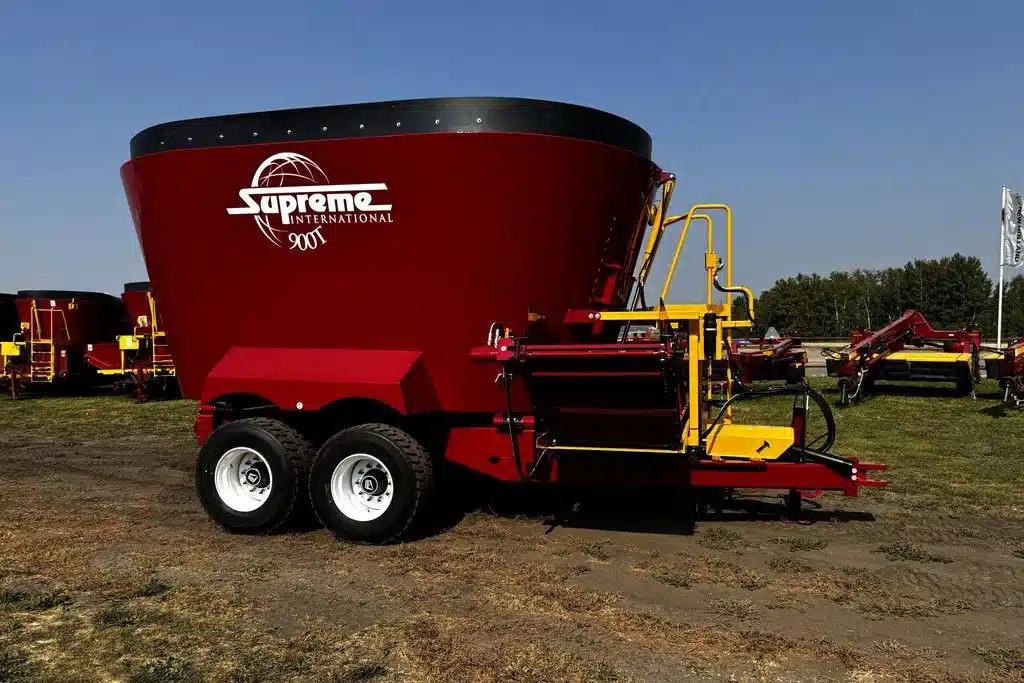Although total mixed ration (TMR) mixers have been popular on dairy operations historically, they are becoming more common on beef operations, as well.
TMR mixers are used primarily for ruminant animals. For both dairy and beef, there are benefits and challenges to implementing a TMR mixer into an operation.
- VIDEO: How beef cattle operations can benefit from a TMR mixer
- VIDEO: Producer feedback built into design of Highline’s TMR mixers
- VIDEO: Vertical feed mixers gaining ground with beef producers
- VIDEO: Trioliet feed mixer gets kudos from feedlot operator
TMR mixer 101
TMR mixers usually combine hay, silage, straw and minerals. There are multiple types of mixers, such as reel or rotary mixers, horizontal auger mixers and vertical mixers. The reel mixers include two augers and one slow-turning reel. A horizontal auger mixer has four augers — two that move the feed forward and two that move the feed back.
Read Also

Treaty Land Sharing Network expands reach in Saskatchewan and Alberta
The Treaty Land Sharing Network, which connects land holders with First Nations and Metis people, has expanded since it began in 2018
The vertical mixer is the primary mixer on the market and the type demoed at Ag in Motion. One or two augers pick up the material vertically to mix it.
Glenn Buurma, the president of Penta Equipment, said with a vertical mixer, every mouthful is the same for the cattle, and producers can mix whatever they want.
“We can take a not-so-great bale and add it with a nicer bale and get a great ration,” he said. “We can take corn stalks and add some wet feed with corn stalks and have an awesome ration. The versatility, the simplicity — there’s very few moving parts on them — and there’s really nothing that it’ll say no to.”
Dairy versus beef
In the midst of the usual bustle at Ag in Motion, near Langham, Sask., people wearing ball caps and cowboy hats brush sweat off their foreheads as they wait for the TMR mixer demos to start. Tractors pulling TMR mixers line up, then the demo begins. Attendees watch, arms crossed over their chests.
Four companies demoed their TMR mixers, including Highline Manufacturing, Jaylor, Penta Equipment and Trioliet Feeding Technology.
Buurma said that vertical mixers were more common on dairy operations in the ’90s and in the early 2000s. But that’s changing.
“Our beef numbers of who we sell to, the end-user, keeps increasing way more than dairy farmers are,” he said in an interview.
“Sometimes we can have the blinders on in life and we just don’t want to spend any money. But there’s nothing that’s going to have a quicker payback for a beef farmer than a feed mixer.”
Ben Meinen is the territory manager of Trioliet. He said their customers are primarily on the dairy side of things, and attributes this to how tight the margins can be in the beef industry.
“On a dairy farm, if you change your ration, within a week you can see a difference in your milk check and your butter fat,” Meinen said. “And a beef cow, before it puts on weight and the quality of the weight, that takes the whole growing season. So the results aren’t there, and then what do you attribute it to? It could be feed, it could be weather, it could be whatever.”
However, like Buurma, he said lately he has seen more interest in TMR mixers on the beef side.
Benefits
When it comes to TMR mixers on beef operations, there are lots of possibilities. Jaylor’s ruminant nutritionist, Alan Vaage, said the biggest problem with beef production is waste with hay feeders and round bales.
“With a TMR mixer, on average we’re probably looking at 20 to 30 per cent savings in terms of forage use. That can even go as high as 50 per cent. Many customers who switch to a Jaylor mixer or a TMR mixer in general will find… they use only about half the amount of hay that they have used in previous years.”
He said because the mixer combines forages with hay and grain to make an ideal ration, each animal gets the proper share of nutrition, even if it’s timid.
Vaage said when producers are trying to determine how to get the best ration for their animals, they should consult with a nutritionist.
“The provincial governments have (nutritionists) to actually build a proper ration that has the protein and the energy content and the minerals that are appropriate for the animal, and its time of production. And then you get the greatest benefit out of programmed feeding,” Vaage said.
Vaage said one of the biggest challenges when it comes to TMR mixers is getting one that is the right machine for the size of your operation. In the beef industry, where margins are tight, it’s important to get the right size mixer that will work for you and is economical.
“Five-by-six bales need large equipment to properly process and feed out,” Vaage said. “If you have a smaller herd then having a mixer that can handle that — or pre-processing feed within the bale to allow you to take part of it and put it into a smaller mixer — can make a more economical choice for their operation.”
Claude Rouault, director of international sales for Highline Manufacturing, said a total mixed ration for beef cattle requires a different focus than with dairy cattle. With dairy cattle, the focus is on the milk production. For beef cattle, the focus is on lean tissue development.
“You can tailor that ration to what the producer is looking to do,” Roualt said. “And so again, it’s very critical that they’re testing their feed knowing exactly what’s going in, but the TMRs allow you to do that by blending all this product, getting a really good, homogenized blend of product.”
Models
Trioliet custom-makes all its products, so when it comes to a mixer for beef producers, they can be created to fit specific operations.
Meinen said they have had customers purchase their products who run large feedlots and specialize the mixers to their needs.
“His feedback is amazing,” Meinen said. “He said, ‘My carcass quality is better at the plant.’ Because he feeds so many cows, he can dedicate the Trioliet just through certain pens, and his days-to-market has shortened.”
At Ag in Motion, Trioliet demoed its Solomix P2 mixer, which has a straw blower to blow the straw over the cattle and into the pen. Meinen said it can blow straw up to 80 feet, allowing producers to bed down while feeding, therefore saving time.
Penta demonstrated the 6730 feed wagon. This mixer has a stainless-steel conveyor belt and a heavy apron chain. Buurma said it is a low-profile machine.
Jaylor demoed its 5850HD, with square-cut augers. Brad Backs, the territory manager of Jaylor, said this product is a commercial-grade mixer and can feed 2,000 to 5,000 head easily.
Highline demoed the AMX850T, which has twin vertical mixing screws and 10 knives maximum.
To pick the right TMR mixer, beef producers should look at the quality of materials used in each product, the capacity of the products, the price range and what extra accessories would be necessary to meet their needs.






















